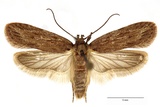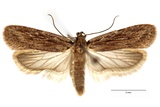Depressaria daucella ([Denis & Schiffermüller], 1775) Species
Last modified: Dec. 8, 2025, 4:49 p.m.
A very rare and local species in Belgium, but probably overlooked in many regions. Recent observations only from the northern part of the country.
Details
- Classification
- Family: Depressariidae > Subfamily: Depressariinae > Genus: Depressaria > Species: Depressaria daucella
- Vernacular names
- Karwijplatlijfje (NL)
- Synonyms
- Depressaria nervosa sensu auct., nec Haworth, 1811
- First mention in Belgium
- De Crombrugghe G. 1906a. Catalogue raisonné des Microlépidoptères de Belgique. — Mémoires de la Société entomologique de Belgique XIII: 1–172; XIV: 1–155. On page 50 (as Depressaria Nervosa Hw.). view page
- Status
-
Native
Distribution
Caterpillar
Bluish grey, with many conspicuous white-ringed raised black spinacula on all segments; head capsule black, prothoracic plate dark brown, last abdominal segment ochreous to dark brown.
Bionomics
The eggs are oviposited singly.
At first, the larva mines in the flowering stems and umbels of their host plant. In a later stage, the larva feeds within a tough silken spinning externally among flowers and developing seeds. Larval stage from the end of May till early August.
Pupation in a flimsy silken cocoon in a hole in the main stem of the food plant. If the potential pupation side is too small in diameter, it pupates in the soil or among plant debris on the ground. Pupal stage in July–August.
The species hibernate in the adult stage. Adults are active at night and come to light.
Flight periods
One generation a year from late August till April or later.
Observed on
- Host plant (species):
- Carum verticillatum, Oenanthe aquatica and Oenanthe crocata
- Host plant (genera):
- Oenanthe
Several species of Oenanthe, like O. aquatica, O. crocata, O. fistulosa or O. pimpinelloides. The caterpillar has also been recorded on Carum verticillatum or Sison amomum.


